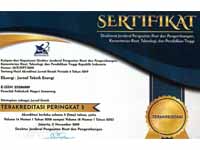Performance Analysis of Tray Dryer to Reduce the Drying Process Time of Cayenne Pepper
DOI:
https://doi.org/10.32497/eksergi.v18i3.3764Keywords:
chili, drying, drying oven, moisture contenct, processing timeAbstract
Chili is a type of vegetable that is easily damaged and difficult to maintain in fresh form. The durability of fresh chilies if stored at low temperatures can last up to 14 days, but if stored at room temperature chilies only last about 2-4 days. Because of this, chili prices are always erratic, when chili prices are low, farmers will overcome losses by drying chilies using natural methods of sunlight. This method is considered less effective because it requires a large drying area and relatively long drying time. Therefore, it is necessary to manufacture and test chili drying ovens to speed up the drying process time and increase the durability of chilies. This research method focuses on the process of testing the performance of the drying oven. The test parameter used is using temperature of 70℃ with 3 variations of drying process time, namely 6 hours, 7 hours, and 8 hours to produce dry chili water content according to the standard, which is a maximum of 11%. The results of the chili drying oven research are the best drying time for 8 hours with a temperature of 70℃ which produces a water content of 9.33% cayenne pepper. In addition, the drying oven testing process resulted in a drying efficiency of 35.4%.
References
Balogun, A. L., Uthman, F., Ajiboye, A. T., & Olawoyin, A. O. Development of Tray Dryer for Pumpkin Seed. International Journal of Environmental Sciences. Vol. 3 No. 4 Pp. 202 - 205, 2014.
Bergman, Theodore L, et. all. Introduction to Heat Transfer Sixth Edition. John Willey & Sons, Inc, 2011.
Cengel, Yunus A dan Afshin J. G. Heat and Mass Transfer fundamental & applications: Fifth Editon. McGraw-Hill Education, 2 Penn Plaza, New York: 1998.
Departemen Pertanian. Standar Nasional Indonesia (01-3389-1994) Standar Uji Cabai Kering. Badan Statistik Indonesia (BSN) : Jakarta: 1994.
Djafar, Z., Piarah, W. H., Djafar, Z., & Riadi, R. Analisis Prestasi Pengering Kopi Berbasis Bahan Bakar Gas (LPG). Prosiding Seminar Ilmiah Nasional Sains dan Teknologi, Volume 4, 2018.
Haryanti, N. et al. Rancang Bangun Kerangka Turbin Ulir Archimedes untuk Pembangkit Listrik Tenaga Mikrohidro Berbantu Perangkat Lunak Solidworks 2016. Kota Tegal: Politeknik Harapan Bersama,
Hasbullah. Cabe Kering dan Cabe Bubuk. Teknologi Tepat Guna Agroindustri Kecil Sumatera Barat. Dewan Ilmu Pengetahuan. Teknologi dan Industri Sumatera Barat, 2001.
Jeyakumar, M., & Christopher, T. Influence of Residual Stresses on Failure Pressure of Cylindrical Pressuser Vessel. Chinese Journal of Aeronautics. China: 2013.
Kusumiyati, Putri, I. E., & Munawar, A. A. Model Prediksi Kadar Air Buah Cabai Rawit Domba (Capsium frutescens L) Menggunakan Spektroskopi Ultraviolet Visible Near Infrared. Agricultural Journal, Vol. 4 No. 1: 15-22, 2021.
Kasmawan, I G A., Sutapa G N., Yuliara, I M., Ratini., Baskoro W T., Trisnawati. Pengenalan Teknologi Pengeringan Cabai Untuk Pemberdayaan Kelompok Tani. Buletin Udayana Mengabdi. Vol. 20 No. 03, 2021.
Murti, K. H. Pengaruh Suhu Pengeringan Terhadap Kandungan Vitamin C Buah Cabai Keriting Lado F1 (Capsicum Annum L). Jurnal Keteknikan Pertanian Tropis dan Biosistem , Vol. 5 No. 3, 2017.
Pardi, Jamal, & Santoso, B. Desain Oven Pengering Ikan Lomek Kapasitas 75 Kg Dengan Bahan Bakar Limbah. Jurnal InovTek Politeknik Negeri Bengkalis, Vol. 8 No. 2, 2018.
S, Abasi., S, M. Mousavi., M, Mohebi., & S, Kiani. Effect of Time and Temperature on Moisture Content , Shrinkage, and Rehydration of Dried Onion. Iranian Journal of Chemical Engineering, Vol. 6 No. 3, 2014.
Saimin. Wawancara Mengenai Metode Proses Pengeringan Cabai Rawit. 03 January 2022.
Suszanowicz, Dariusz. Optimation of Heat Loss through Ventilation for Residential Buizldings. Atmosphere 9, 95. University of Opole Poland, 2013.
Weiwei , W., Zhaofeng , C., Xinyang, Z., LIhe, C., & Shengnan, G. Study of Fabrication and Properties of the Alumunium Foil/Bubble Composite. 21st International Conference on Composite Materials, 2017.
Downloads
Published
Issue
Section
License
Authors who publish with this journal agree to the following terms:Authors retain copyright and grant the journal right of first publication with the work simultaneously licensed under a Creative Commons Attribution License that allows others to share the work with an acknowledgement of the work's authorship and initial publication in this journal.
Authors are able to enter into separate, additional contractual arrangements for the non-exclusive distribution of the journal's published version of the work (e.g., post it to an institutional repository or publish it in a book), with an acknowledgement of its initial publication in this journal.
Authors are permitted and encouraged to post their work online (e.g., in institutional repositories or on their website) prior to and during the submission process, as it can lead to productive exchanges, as well as earlier and greater citation of published work (See The Effect of Open Access).






